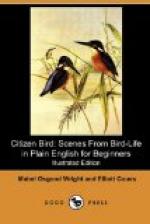Then the Doctor laughed and said: “The people who have studied the birds, bone by bone and feather by feather, have grouped these Citizens into orders and families to prevent confusion, so that we may easily tell the relationship between them. These lists sometimes begin with the lowest order, nearest to the crawling, reptile brethren,—the least interesting, far-away birds that have no song and cannot fly well, but swim and dive in the water,—and end with the beautiful singing birds that live in our gardens.”
“Couldn’t you begin with the dear singing birds and end with the far-away clumsy diving ones?” asked Rap earnestly; “it’s so much easier learning about things near home.”
“You are right, my boy. In learning anything, whether of bird, insect, or flower, begin at home, and let this be the centre from which you work your way onward and outward. Then you will be sure of what you learn; and ever afterward, though you may follow strange birds all over the known world, you will come home again, to find that there are none more charming and lovable than those few whose acquaintance you will make this summer.
“I do not wish you to be confused by long words, so I shall give you their plain English names and divide these birds of our stories into six classes. By and by, when you have heard a few facts about them, we will group them into families; and I will tell you so much that, if you use your eyes well, you will be able to name any one of these birds when you see it out in the open air. You must always remember, children, when you see birds flying about, that you will not notice many little markings and bits of color that would be quite plain to you if you held the bird in your hand, or looked at it in a case, as you look at these stuffed ones now. A bird, whose breast is spotted may look striped when seen at a distance.
“When you are in doubt about the name of a bird that you have seen, you can come here and look for it; but very few children can do so. At best they can only look at pictures, and I do not wish you to depend upon the specimens in this room.”
“No,” said Rap, “because if our bird stories are printed, and other children read them, they may not have an uncle with a ‘wonder room’; and so they must learn the names without.”
“That is another reason why we must have a great many pictures in our book, for these children,” said the Doctor. “Now write the names of the six classes into which all our birds are to be gathered.
“I. The Birds that Sing.
“II. The Birds that Croak and Call.
“III. The Birds that are Cannibals.
“IV. The Birds that Coo and Scratch.
“V. The Birds that Wade and Paddle.
“VI. The Birds that Swim and Dive.”
Squeak, squeak, went three pencils, two going fast and one toiling along as if it was lame and needed sharpening.
“Please, uncle, what birds are cannibals?” asked Dodo, as she finished writing this last word slowly, taking great pains. “I thought cannibals were people that ate each other.”




